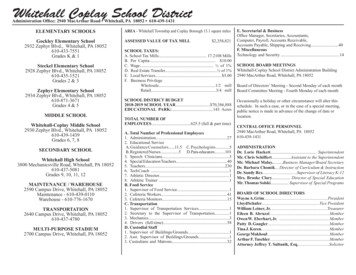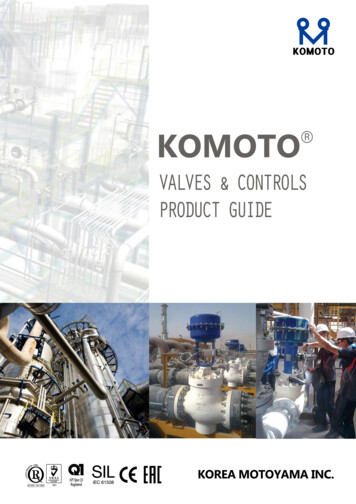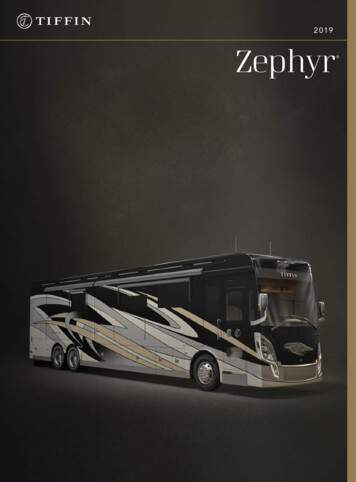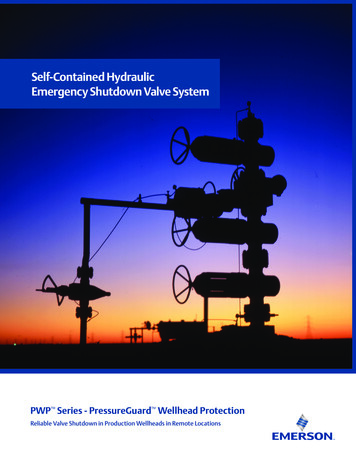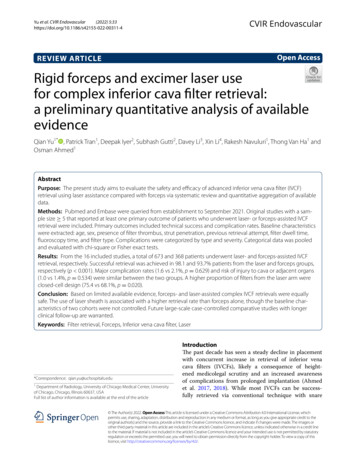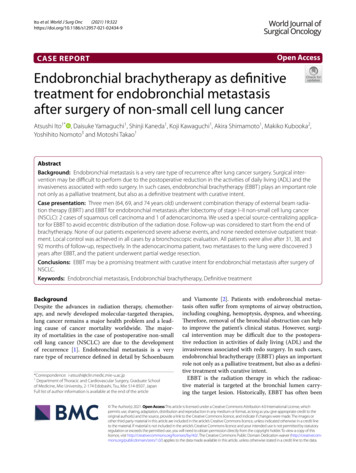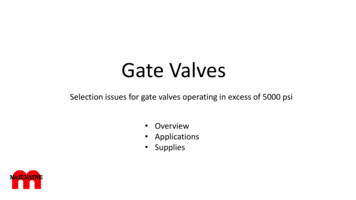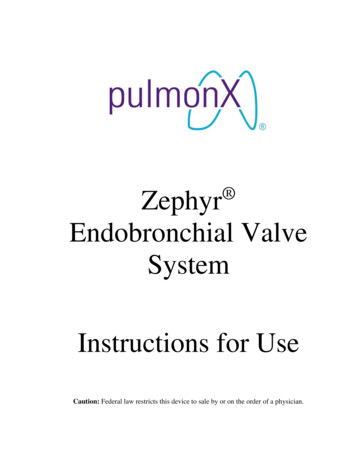
Transcription
ZephyrEndobronchial ValveSystemInstructions for UseCaution: Federal law restricts this device to sale by or on the order of a physician.
Zephyr EBV System IFU (US)Table of ContentsPulmonx Zephyr Endobronchial Valve (EBV ) System Description . 31.01.1Required Equipment . 31.2System Components . 32.0Indications for Use . 43.0Contraindications . 44.0Warnings . 45.0Precautions . 45.1General Precautions. 45.2Magnetic Resonance Imaging (MRI) Safety Information. 55.3Target Lobe Selection . 55.4Pneumothorax Management . 56.0Clinical Experience . 66.1 LIBERATE Study: Lung Function Improvement after Bronchoscopic LungVolume Reduction with Pulmonx Endobronchial Valves used in Treatment ofEmphysema . 6Study Objective . 6Study Design . 6Key Inclusion Criteria . 6Key Exclusion Criteria . 7Follow-up . 8Endpoints . 8Demographics . 8Results . 9Effectiveness . 9Adverse Events . 14Conclusion . 166.2 IMPACT Study: A Multi-center, Prospective, Randomized, Controlled, one-wayCrossover Investigation of Endobronchial Valve (EBV) Therapy vs. Standard of Care(SoC) in Homogeneous Emphysema . 16Study Objective . 16Study Design . 16Follow-up . 16Endpoints . 17Demographics . 17Pulmonx Corporation1
Zephyr EBV System IFU (US)Results . 18Effectiveness . 18Adverse Events . 21Conclusion . 226.3 TRANSFORM Study: Multi-center, Prospective, Randomized, Controlled Trialof Zephyr Endobronchial Valve (EBV ) Treatment vs. Standard of Care (SoC) inHeterogeneous Emphysema . 22Study Objective . 22Study Design . 23Follow-up . 23Endpoints . 23Demographics . 23Results . 24Effectiveness . 24Adverse Events . 26Conclusion . 287.0Adverse Events . 298.0Operator’s Instructions. 308.1Delivery Catheter Preparation . 308.2Zephyr Endobronchial Valve Loading . 318.3Delivery Catheter Placement . 358.4Zephyr Valve Deployment . 368.5Zephyr Valve Removal . 399.0Storage . 4010.0Patents and Trademarks . 4011.0Symbols. 41Pulmonx Corporation2
1.0Pulmonx Zephyr Endobronchial Valve (EBV ) System DescriptionThe Zephyr Endobronchial Valve (Zephyr Valve) is an endobronchial implant designed toocclude airflow in the target lobe and thereby reduce lung volume. The device consists of a oneway silicone duckbill valve attached to a nickel-titanium (Nitinol) self-expanding retainer that iscovered with a silicone membrane. It is implanted in the target bronchus during a bronchoscopyprocedure using the Zephyr Endobronchial Delivery Catheter (EDC) that is guided to thetargeted bronchus by inserting it through the working channel of an adult bronchoscope.Successful lobar occlusion may require placement of multiple Zephyr Valves in bronchi of thetarget lobe. The Zephyr Valves permit air to vent out of the treated lobe during exhalation but donot permit refilling of this region during inhalation to reduce hyperinflation due to emphysema.Trapped air in the diseased lobe escapes through the Zephyr Valves until the lung volume of thetreated lobe is reduced.The Zephyr Valve is designed to be a permanent implant, but can be removed, if necessary.MembraneRetainerValve ProtectorValveFigure 1Zephyr Valve1.1Required EquipmentAdult flexible bronchoscope (working channel 2.8 mm)1.2 System ComponentsZephyr 4.0 Endobronchial Valve (Zephyr 4.0 EBV)Zephyr 4.0-LP Endobronchial Valve (Zephyr 4.0-LP EBV)Zephyr 5.5 Endobronchial Valve (Zephyr 5.5 EBV)Zephyr 4.0 Endobronchial Delivery Catheter (Zephyr 4.0 EDC)Zephyr 4.0-J Endobronchial Delivery Catheter (Zephyr 4.0-J EDC)Zephyr 5.5 Endobronchial Delivery Catheter (Zephyr 5.5 EDC)Pulmonx Corporation3
The Zephyr 4.0 EDC and Zephyr 4.0-J EDC, which have blue marker bands, are configured todeliver the Zephyr 4.0 EBV and Zephyr 4.0-LP EBV. The Zephyr 5.5 EDC, which has greenmarker bands, is configured to deliver the Zephyr 5.5 EBV.2.0Indications for UseThe Pulmonx Zephyr Endobronchial Valves are implantable bronchial valves indicated for thebronchoscopic treatment of adult patients with hyperinflation associated with severe emphysemain regions of the lung that have little to no collateral ventilation.3.0ContraindicationsThe Zephyr Valve is contraindicated for: Patients for whom bronchoscopic procedures are contraindicated Patients with evidence of active pulmonary infection Patients with known allergies to Nitinol (nickel-titanium) or its constituent metals (nickelor titanium) Patients with known allergies to silicone Patients who have not quit smoking Patients with large bullae encompassing greater than 30% of either lung4.0WarningsThe Zephyr Valve should be used with caution and only after careful consideration in patientswith: Prior lung transplant, LVRS, median sternotomy, or lobectomy Congestive heart failure or recent myocardial infarction FEV1 15% of predicted valueThe Zephyr EDC handle contains strong permanent magnets. To avoid interference and possiblepatient/clinician harm, keep it more than 2 inches away from medical devices that could beaffected by the magnetic fields, including, but not limited to pacemakers, cochlear implants, andneurostimulators. Additionally, strong magnetic fields may cause damage to magnetic datastorage media and electronic equipment if brought within two inches of the Zephyr EDC.5.0Precautions5.1General PrecautionsRead all labels and instructions prior to use. Use is restricted to a physician trained in the use ofthis device. The Zephyr Valve and EDC are intended for single-patient use only. Do not re-sterilize.No assurance of sterility can be made if devices are re-used. Do not attempt to reload a Zephyr Valve. Do not use the device if the sterilization barrier has been damaged or if the device isdropped after removal from sterile packaging. Performance of the Zephyr Valve has not been assessed in physiological conditionsunique to air leak patients with an open thoracic window (also known as a ClaggettWindow or Eloesser Flap). The Zephyr Valve device may be subject to fracture due tounusual physical forces in this setting. Safety in uncontrolled pulmonary hypertension has not been evaluated.Pulmonx Corporation4
The Zephyr Valve was evaluated in patients with heterogenous emphysema in the pivotaltrial, LIBERATE Study (Section 6.1). Limited data on the use of this device inhomogenous emphysema patients came from the OUS IMPACT trial (Section 6.2).5.2Magnetic Resonance Imaging (MRI) Safety InformationNon-clinical testing has demonstrated the Zephyr Endobronchial Valve (i.e., 4.0 EBV, 4.0-LPEBV, and 5.5 EBV) is MR Conditional. A patient with this valve can be safely scanned in anMR system meeting the following conditions: Static magnetic field of 3.0 T, or lessMaximum spatial field gradient of 4,000 gauss/cm (40 T/m)Maximum MR system reported, whole body averaged specific absorption rate (SAR) of 4W/kg (First Level Controlled Operating Mode)Under the scan conditions defined above, the Zephyr Endobronchial Valve (i.e., 4.0 EBV, 4.0-LPEBV, and 5.5 EBV) is expected to produce a maximum temperature rise of less than 2.7 C after15 minutes of continuous scanning.In non-clinical testing, the image artifact caused by the Zephyr Endobronchial Valve (i.e., 4.0EBV, 4.0-LP EBV, and 5.5 EBV) extends approximately 5 mm from the valve when imagedwith a gradient echo pulse sequence and a 3.0 T MRI system.The Endobronchial Loader System (ELS) and the flexible Zephyr Endobronchial DeliveryCatheter (EDC) are not tested for their compatibility with MR environment and are MR unsafe.5.3Target Lobe SelectionZephyr Valves should be used in diseased lobes with little to no collateral ventilation from aneighboring lobe(s). The LIBERATE Study, IMPACT Trial, and TRANSFORM Study allassessed collateral ventilation utilizing the Chartis Pulmonary Assessment System whichprovides a physiological measure of air flow.Patients in whom the targeted lobe for treatment is not the most diseased (due to factors such ascollateral ventilation or other abnormalities), who have a contralateral lung with a 60%emphysema destruction score (at -910 HU), could be at higher risk for a complex pneumothorax(defined as requiring removal of all valves or resulting in death) if a pneumothorax occurs. In theevent the most diseased lobe is not the target lobe and the contralateral lung has 60%emphysema destruction score (at -910 HU), Zephyr Valve treatment should only be performedafter careful consideration and appropriate discussion of the risk with the patient. Patient shouldbe carefully observed post-procedure.5.4Pneumothorax ManagementPneumothorax is a commonly occurring side effect of Zephyr Valve treatment. In LIBERATE,seventy-six percent (76%) of pneumothoraces occur within the first 3 days of a procedure.Patients should remain in-hospital for the first 3 nights after a procedure and should be providedwith clear instructions on recognizing symptoms of a pneumothorax and to seek emergent help ifexperiencing these symptoms.Pulmonx Corporation5
In the event a pneumothorax occurs, pneumothorax management should be per expertrecommendations1. A chest x-ray must be completed within the first four (4) hours and then 24hours after the procedure as routine clinical practice. Patient should be discharged according tothe physician’s clinical judgement.6.0Clinical ExperienceThe safety and effectiveness of the Zephyr Endobronchial Valve (EBV) in patients with little tono collateral ventilation in the treated lobe has been demonstrated in 3 multicenter randomizedclinical studies in subjects with both severe heterogeneous and homogeneous emphysema andabsence of collateral ventilation. These studies included: LIBERATE Study, see Section 6.1 IMPACT Trial, see Section 6.2 TRANSFORM Study, see Section 6.36.1LIBERATE Study: Lung Function Improvement after Bronchoscopic Lung VolumeReduction with Pulmonx Endobronchial Valves used in Treatment of EmphysemaStudy ObjectiveThe LIBERATE Study was a prospective randomized, controlled study designed to assess thesafety and effectiveness of bronchoscopic lung volume reduction (BLVR) using the ZephyrEndobronchial Valve (EBV) in treated study subjects compared to standard-of-care Controlsubjects to support a premarket approval application to FDA.Study DesignThe LIBERATE Study was a multicenter, prospective, randomized, controlled, one-waycrossover study. Subjects were enrolled and randomized at 24 Investigational sites in the US andoutside the US (OUS). Qualifying subjects with heterogeneous emphysema were randomized ata 2:1 ratio into either the Zephyr EBV treatment arm or Control (Standard of Care) arm. Thesubjects in the EBV arm had Zephyr EBVs placed in the target lobe to achieve lobar occlusion.Both the Zephyr EBV and Control group subjects continued to receive optimal medicalmanagement according to current clinical practice. Following their 12-month evaluation, theControl group subjects had an option to cross over to Zephyr EBV treatment, if eligible.Key Inclusion Criteria1. Signed Screening or Study Procedure Informed Consent using a form that wasreviewed and approved by the IRB.2. Age 40 to 75 years.3. BMI less than 35 kg/m2.4. FEV1 between 15% and 45% of predicted value at baseline exam5. Post-rehabilitation 6-minute walk distance between 100 meters and 500 meters atbaseline exam.6. Stable with less than 20 mg prednisone (or equivalent) daily.1Valipour, Arschang, et al. "Expert statement: pneumothorax associated with endoscopic valve therapy foremphysema-potential mechanisms, treatment algorithm, and case examples." Respiration 87.6 (2014): 513-521.Pulmonx Corporation6
7. Nonsmoking for 4 months prior to screening interview.8. Current Pneumococcus vaccination.9. Current Influenza vaccination.10. Little to no collateral ventilation (CV-) as determined using the Chartis System.Key Exclusion Criteria1. Clinically significant (greater than 4 tablespoons per day) sputum production.2. Two or more COPD exacerbation episodes requiring hospitalization in the lastyear at screening.3. Two or more instances of pneumonia episodes in the last year at screening.4. History of exercise-related syncope.5. Myocardial Infarction or congestive heart failure within 6 months of screening.6. Prior lung transplant, LVRS, bullectomy or lobectomy.7. Clinically significant bronchiectasis.8. Unable to safely discontinue anti-coagulants or platelet activity inhibitors for 7days.9. Uncontrolled pulmonary hypertension (systolic pulmonary arterial pressure 45mm Hg) or evidence or history of CorPulmonale as determined by recentechocardiogram (completed within the last 3 months prior to screening visit).10. Pulmonary nodule requiring surgery as noted by chest X-ray or CT scan.11. HRCT collected per CT scanning protocol within the last 3 months of screeningdate and evaluated by clinical site personnel using Myrian CT software(K071000) shows:a. Parenchymal destruction score of greater than 75% in all three right lobesor both left lobes.b. Emphysema heterogeneity score less than 15% (Not Applicable forCrossover subjects as of Revision H of protocol).c. Large bullae encompassing greater than 30% of either lung.d. Insufficient landmarks to evaluate the CT study using the software as it isintended.12. Left ventricular ejection fraction (LVEF) less than 45% as determined by recentechocardiogram (completed within the last 3 months prior to screening visit).13. Resting bradycardia ( 50 beats/min), frequent multifocal PVCs, complexventricular arrhythmia, sustained SVT.14. Post-bronchodilator FEV1 less than 15% or greater than 45% of predicted value atscreening.15. TLC less than 100% predicted (determined by body plethysmography) atscreening.16. RV less than 175% predicted (determined by body plethysmography) atscreening.17. DLCO less than 20% predicted value at screening.18. 6-minute walk distance less than 100 meters or greater than 450 meters atscreening.19. PaCO2 greater than 50 mm Hg (Denver greater than 55 mm Hg) on room air atscreening.20. PaO2 less than 45 mm Hg (Denver less than 30 mm Hg) on room air at screening.Pulmonx Corporation7
21. Elevated white cell count ( 10,000 cells/μL) at screening.22. Plasma cotinine level greater than 13.7 ng/ml (or arterial carboxyhemoglobin 2.5% if using nicotine products) at screening.23. Evidence of collateral ventilation (CV ) as determined using the Chartis System.Follow-upSubjects in both arms were followed-up at 45-days, 3-months, 6-months, 9-months, and 1-year.Subjects in the Zephyr EBV treatment arm had additional daily phone call follow-ups for thefirst ten (10) days, and office visits at 7-days and 30-days.Annual follow-up visits out to 5 years are planned for the Zephyr EBV treatment arm andControl Subjects that crossed over to the Zephyr EBV treatment arm after completing their 12months follow-up.EndpointsThe primary effectiveness endpoint was the percentage of study subjects in the ZephyrEndobronchial Valve (EBV) treatment arm who meet the threshold of 15% improved forcedexpiratory volume in one second (FEV1) as compared to the Control arm at 1 year.The secondary effectiveness endpoints included:1) FEV1: Difference between study arms in absolute change from baseline for FEV1 at 1year.2) Six-Minute Walk Distance (6MWD): Difference between study arms in absolute changefrom baseline for 6MWD at 1 year.3) St. George’s Respiratory Questionnaire: Difference between study arms in absolutechange from baseline for SGRQ score at 1 year.Other endpoints included additional measures of lung function, exercise capacity, breathlessness,and quality of life. Adverse Events and Serious Adverse Events2 were evaluated for theTreatment Period (Day of Procedure to 45 days), and Long-Term Period (46 days after procedureto 12 months).DemographicsA total of 190 subjects were randomized at 24 centers in US and OUS, 128 subjects in theZephyr EBV group and 62 subjects in the Control group. Except for a higher proportion ofGOLD Stage IV subjects in the Control group (74.2% vs 57.8% in the Zephyr EBV group), therewere no other differences in any of the baseline demographic or clinical characteristics betweenthe randomized groups showing that both groups were well matched with no confounders atBaseline. Subject baseline demographics and clinical characteristics are presented in Table 1.2A serious adverse event (SAE) is any untoward medical occurrence that: results in death, is life-threatening,requires inpatient hospitalization or prolongation of existing hospitalization, or results in persistent or significantdisability/incapacity, or congenital anomaly/birth defect.Pulmonx Corporation8
Table 1LIBERATE Baseline Demographics and Clinical CharacteristicsZephyr EBV(n 128)Control(n 62)t-testp-value56 Males (44%)72 Females (56%)33 Males (53%)29 Females (47%%)0.278bAge (years)64.0 6.862.5 7.10. 161aBMI (kg/m2)24.67 3.9024.32 4.380.577aPack-Year smoking history50.78 26.8848.59 28.480.606a54 (42.2%) Stage III74 (57.8%) Stage IV16 (25.8%) Stage III46 (74.2%) Stage IV0.037b0.763 0.2520.752 0.217VariableGenderGOLD StagecForced Expiratory Volume in 1sec. (FEV1) (L)- PostbronchodilatorForced Expiratory Volume in 1sec. (FEV1) (% predicted)- Postbronchodilator0.767a28.0 7.4526.2 6.280.101aResidual Volume (RV) (L)4.709 1.0464.759 0.9010.752aResidual Volume (% predicted)224.5 42.45224.6 38.860.987aTotal Lung Capacity (TLC) (L)7.537 1.5937.634 1.3690.683aTotal Lung Capacity (%predicted)133.5 21.17130.2 12.440.256aFEV1/FVC (%)0.302 0.0630.294 0.0630.421aRV/TLC (%)0.631 0.0860.626 0.0730.689a6 Minute Walk Distance (m)311.33 81.33301.91 78.540.450aSGRQ Total score55.15 14.0953.10 14.140.352aValues are means SDaP-value from two-sided t-test assuming equal variance.bP-value from two-sided Fisher’s exact test.cClassification of airflow limitation severity in COPD (based post-bronchodilator FEV1):GLOBAL STRATEGY FOR THE DIAGNOSIS, MANAGEMENT, AND PREVENTION OFCOPD (2017 REPORT)ResultsEffectivenessThe Primary Endpoint for the Study was met. A greater number of subjects in theZephyr EBV group compared to the Control group achieved a Post-bronchodilator FEV1(L) improvement from Baseline of 15%; the difference between groups is 31.0%(p 0.001), see Table 2 and Figure 2.Pulmonx Corporation9
Table 2Primary Analysis of the Primary Effectiveness Endpoint(Intent-to-Treat Population)Percent of Subjects with 15%Improved Post-Bronchodilator FEV1 at1 YearZephyr EBV(N 128)Control(N 62)Delta(95% CI)47.7%16.8%31.0%(18.0% to 43.9%)Z-statisticP-value4.130 0.001Note:To account for the interim analysis, Z 2.004 is the threshold for significance. Intermittent missing valuesimputed with linear interpolation. Truncated missing values imputed with multiple imputation (propensityscore method). Death prior to 1-year endpoint imputed as failure. Values have been adjusted for multipleimputation. Averages across imputations are presented for Z and p-value.Figure 2Primary Effectiveness Endpoint- Percent of Subjects with FEV1Improvement of 15% at 12-monthsThe Secondary Endpoints for the Study were met. All three Secondary effectivenessendpoints showed statistically significant and clinically meaningful improvements infavor of Zephyr EBV treatment over the Control, see Figure 3.Pulmonx Corporation10
The post-bronchodilator FEV1 absolute change showed significantly greater meanimprovement (volume increase) in the Zephyr EBV group compared to the Control group(ΔEBV – Control 0.106L, p 0.001).The Six-Minute Walk Distance showed significantly greater mean improvement(increased distance walked) in the Zephyr EBV group compared to the Control group(ΔEBV – Control 39.31 meters, p 0.002).The St. George’s Respiratory Questionnaire (SGRQ) showed significantly greater meanimprovement (score reduction) in the Zephyr EBV group compared to the Control group(ΔEBV – Control 7.05, p 0.004).Figure 3Secondary Effectiveness EndpointsAt 12-months, there was an improvement in all Lung Function Measures, ExerciseCapacity and Quality of Life Measures, including dyspnea, in favor of the Zephyr EBVgroup. The mean differences between the Zephyr EBV and Control groups for thechanges from Baseline to 12-months are shown in the Table 3. The durability of key andadditional effectiveness outcomes is shown graphically in Figure 4.Pulmonx Corporation11
Table 3Zephyr EBV Group Changes from Baseline at 12-months (ITT Population)Lung Function MeasuresZephyr EBV Group Mean ChangeTreated Lobe Volume Reduction (TLVR; L)EBV from Baseline1.142Change in Residual Volume (RV; L)Δ EBV - Control-0.522Change in Total Lung Capacity (TLC; L)Δ EBV - Control-0.288Change in FEV1/FVC ratioΔ EBV - Control0.01Change in RV/TLC ratioΔ EBV - Control-0.05Change in Forced Vital Capacity (FVC; L)Δ EBV - Control0.27Change in Functional Residual Capacity (FRC; L)Δ EBV - Control-0.426Change in Inspiratory Capacity (IC; L)Δ EBV - Control0.159Change in IC/TLC ratioΔ EBV - Control0.034Change in Diffusing Capacity (DLCO)(mL CO/min/mm Hg)Δ EBV - Control0.869Patient-Reported Quality of Life MeasuresChange in SGRQ – Symptoms domain (points)Δ EBV - Control-0.88Change in SGRQ – Activity domain (points)Δ EBV - Control-12.73Change in SGRQ – Impacts domain (points)Δ EBV - Control-9.72Change in CAT score (points)Δ EBV - Control-3.1Change in mMRC Dyspnea score (points)Δ EBV - Control-0.8Change in TDI Focal score (points)Δ EBV - Control4.3Change in TDI Functional Impairment (points)Δ EBV - Control1.4Change in TDI Magnitude of Task (points)Δ EBV - Control1.4Change in TDI Magnitude of Effort (points)Δ EBV - Control1.5Change in EXACT-PRO Total Score (points)Δ EBV - Control-3.8EXACT Breathlessness Score (points)Δ EBV - Control-8.8EXACT Cough and Sputum Score (points)Δ EBV - Control-1.1EXACT Chest Symptoms Score (points)Δ EBV - Control-1.5Change in BODE Index (points)Δ EBV - Control-1.2Change in EQ-5D (points)Δ EBV - Control0.013Change in EQ-5D (VAS) Health State Today (points)Δ EBV - Control2.911Pulmonx Corporation12
Figure 4Durability of Key and Additional Effectiveness OutcomesPulmonx Corporation13
Adverse EventsThe safety of the Zephyr EBV System was assessed by comparing adverse event profilesof the Zephyr EBV and Control group subjects for the Treatment Period (Day ofprocedure/ randomization to 45 days) and Longer-Term Period (46 days after the studyprocedure/ randomization until the 1-year follow-up visit).There were a higher number of serious respiratory adverse events in the Zephyr EBVgroup compared to the SoC group during the Treatment Period (35.2% subjects versus4.8 % subjects). The most common serious respiratory adverse events in the Zephyr EBVversus SoC subjects during the Treatment Period were pneumothorax in 26.6% versus0.0% subjects, respectively; COPD exacerbations in 7.8% versus 4.8% subject,respectively; dyspnea in 1.6% versus 0.0% subjects, respectively; pleural effusion in1.6% versus 0.0% subjects, respectively; and respiratory failure in 1.6% versus 0.0%subjects, respectively.There was a total of 4 deaths (3.1%) in the Zephyr EBV group during the TreatmentPeriod. There were no deaths in the Control group during the Treatment Period. Themajority of pneumothoraces (76%) occurred within 3 days following a bronchoscopyprocedure. Analyses of the pneumothoraces identified two variables that predictedsubjects at higher-risk of having a complex pneumothorax (defined as requiring removalof all valves or resulting in death) and provide a means to prospectively identify thesepatients and consider mitigations. Specifically, patients in whom the targeted lobe fortreatment is not the most diseased (due to factors such as collateral ventilation or otherabnormalities), and the contralateral lung has 60% emphysema destruction score couldbe at higher risk for a complex pneumothorax (defined as requiring removal of all valvesor resulting in death). Patients who experienced a pneumothorax following Zephyr EBVtreatment experienced meaningful clinical benefit once they recovered from thepneumothorax event.In the Longer-Term Period (46 days after the study procedure/ randomization until the 1year follow-up visit), the frequency of respiratory serious adverse events was comparablewith 33.6% of the Zephyr EBV group subjects and 30.6% of the Control group subjectsexperiencing one or more respiratory serious adverse events (p 0.741). Some of thehigher number of adverse events in the Zephyr EBV group during this period wereassociated with protocol allowed bronchoscopy procedures for valve adjustment. Unlikethe Treatment Period, during the Longer-Term Period the Control group had a higherfrequency of COPD exacerbations that were serious adverse even
EBV, and 5.5 EBV) is expected to produce a maximum temperature rise of less than 2.7 C after 15 minutes of continuous scanning. In non-clinical testing, the image artifact caused by the Zephyr Endobronchial Valve (i.e., 4.0 EBV, 4.0-LP EBV, and 5.5 EBV) extends approximately 5 mm from the valve when imaged
